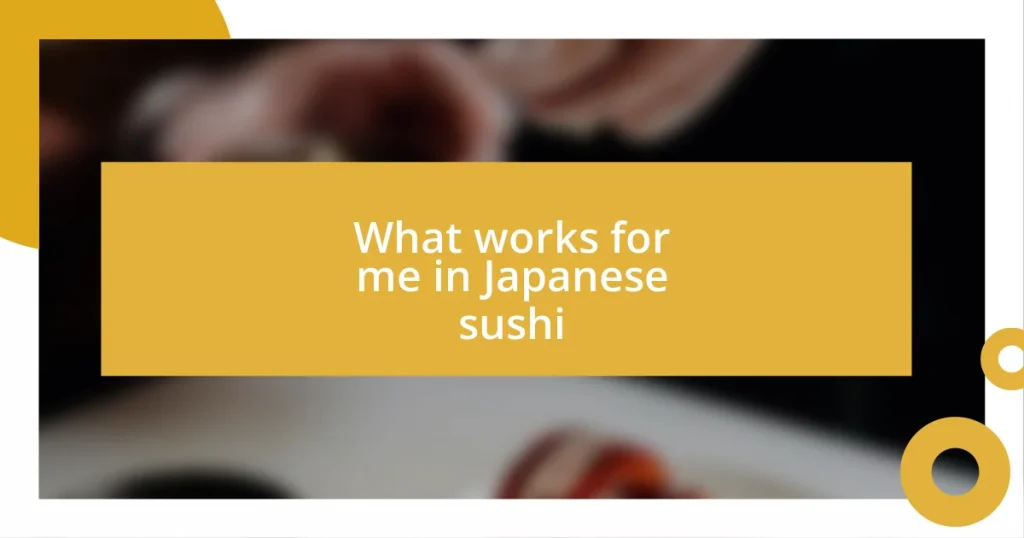Key takeaways:
- Dim sum is a communal dining experience rooted in Chinese culture, emphasizing sharing dishes and stories with loved ones.
- Originating from tea houses along the Silk Road, dim sum evolved into a popular meal with various regional variations and international appeal.
- Understanding and practicing traditional dim sum etiquette, such as serving tea for others first and sharing dishes, enhances the dining experience and fosters connections.

Understanding Chinese dim sum
When I first encountered dim sum, I was struck by how much it felt like a culinary treasure hunt. Each small dish, or “small bite,” invites you to explore a palette of flavors—whether it’s the delicate dumplings or the savory buns. I can’t help but wonder, isn’t it fascinating how something so delightful can bring people together around a shared table?
The beauty of dim sum lies not just in its variety, but also in the customs that accompany it. In my experience, it’s more than just a meal; it’s about the joy of sharing dishes and stories with loved ones. Have you ever shared a steaming basket of siu mai, the steam rising up in a fragrant cloud? It’s moments like these that create lasting memories, igniting a sense of warmth and connection.
Understanding dim sum also means appreciating the artistry involved in its preparation. I remember visiting a dim sum restaurant where I watched chefs deftly fold dumplings with incredible precision. Each fold is a labor of love, a craft honed over years. It makes me think—what stories might these dumplings tell? In every bite, there’s a little piece of history and tradition, inviting us to savor not just the food, but the culture that surrounds it.

The history of dim sum
Dim sum has a fascinating history that dates back to the ancient Silk Road, where traders would stop at tea houses in southern China. These establishments served small bites to accompany tea, which allowed weary travelers to rest and enjoy light, flavorful dishes. I recall feeling a sense of nostalgia during a tea ceremony, realizing that every sip and bite was a tribute to this long-standing tradition of hospitality and warmth.
As dim sum evolved, it became deeply intertwined with Cantonese culture, particularly in Guangdong province. Tea houses transformed into bustling restaurants, with families gathering to enjoy a leisurely meal filled with small plates. I’ve always loved the communal aspect of dim sum; there’s something magical about passing around dishes of har gow and char siu bao, knowing that every bite is steeped in centuries of shared joy and culinary exploration.
Today, dim sum is not only a staple in Chinese cuisine but has also gained international popularity, with countless variations springing up worldwide. I remember my first experience at a dim sum brunch in a vibrant city—how it felt to be surrounded by the chatter of happy diners and the enticing aroma of freshly steamed dumplings. It was in that moment that I realized dim sum is not just food; it’s an experience that transcends borders and cultures, drawing people together through the love of delicious shared meals.
| Era | Characteristics |
|---|---|
| Ancient Silk Road | Small bites served with tea for travelers |
| Cantonese Culture | Evolution into a communal dining experience |
| Modern Day | International popularity with diverse variations |

Exploring dim sum varieties
Dim sum offers a delightful array of options, each with its unique flavor and texture. Personally, my favorite is definitely the har gow, or shrimp dumplings. The translucent wrapper is so delicate, and when you take a bite, you’re met with a burst of juicy, seasoned shrimp. There’s something magical about discovering a new dim sum dish for the first time, like biting into a flaky char siu bao and revealing its sweet, savory pork filling.
Here are some popular dim sum varieties that are worth exploring:
- Siu Mai: Open-topped pork dumplings, garnished with crab roe, bursting with flavor.
- Har Gow: Steamed shrimp dumplings with a glossy, thin skin that glimmers under the dim sum light.
- Char Siu Bao: Soft, fluffy buns filled with sweet and savory barbecued pork.
- Jiaozi: Pan-fried or boiled dumplings that often contain a mix of pork and vegetables, perfect for dipping.
- Egg Tarts: Bite-sized pastries filled with a rich, custardy egg filling, offering a sweet finale.
Every time I sink my teeth into these dishes, I’m reminded of the camaraderie that comes from sharing them with friends. It’s a joy that transcends mere nourishment, creating moments that linger long after the last bite.

Popular dim sum dishes
When it comes to popular dim sum dishes, the variety is truly remarkable. One dish that has fond memories for me is Siu Mai. These open-topped dumplings filled with pork often have a hint of crab roe that enhances their rich flavor. I remember the first time I bit into one—the combination of textures was just perfect. Isn’t it amazing how food can evoke such vivid memories?
Another standout is the classic Char Siu Bao. I can still picture the soft, fluffy bun giving way to that sweet and savory barbecued pork filling. It was at a bustling dim sum restaurant where I first tasted it, and every bite felt like a warm embrace. I can’t help but wonder, how can something so simple become a cherished part of our culinary landscape?
Let’s not forget about Har Gow. Those glossy, translucent shrimp dumplings caught my attention from the moment they arrived at the table. The way the delicate skin held such juicy shrimp made me realize how intricate the craft of dim sum really is. There’s a certain satisfaction in watching those dumplings glide effortlessly onto my plate, reminding me that dim sum is about the artistry of food as much as it is about savoring each bite. Have you had a dish that leaves you thinking about it long after? For me, these dim sum moments are etched in my mind.

Traditional dim sum etiquette
As I dove into the world of dim sum, I quickly learned that etiquette plays a vital role in enhancing the experience. For instance, it’s customary to wait for everyone at the table to arrive before ordering; this gesture shows respect and inclusiveness, making the meal a shared occasion. I remember feeling slightly embarrassed during my first visit when I clumsily tried to order before my friends had settled in—it truly highlighted the importance of unity in this dining tradition.
Another etiquette tip that took me by surprise was the act of serving tea. It’s polite to pour tea for others before filling your own cup, a practice that fosters generosity and camaraderie. The first time I followed this custom, I felt a warm sense of connection with my dining companions, as we engaged in casual conversation over steaming cups. What struck me was how such a simple gesture could elevate the atmosphere and create a more inviting environment.
Lastly, when enjoying dim sum, it’s considered proper to use chopsticks or a spoon, but I believe the real art lies in how we share the dishes. I’ve noticed that taking a smaller portion for yourself and encouraging others to try a bit of everything not only enhances the dining experience but also ignites delightful discussions about flavors and textures. Isn’t it fascinating how food can connect us in such meaningful ways?

How to enjoy dim sum
When diving into the dim sum experience, I always recommend approaching the meal with an open mind and a playful spirit. It’s not just about filling your plate—it’s an invitation to explore flavors that tell a story. I still remember the first time I tried custard buns; the sheer surprise of their sweetness combined with the soft bun was like discovering a hidden treasure. Have you ever tasted something that completely changed your perception of a dish? That’s the magic of dim sum.
Sharing is a fundamental part of relishing dim sum. I’ve found that gathering around a lazy Susan, where each dish spins within reach, adds a layer of excitement and camaraderie to the meal. As we piled our plates high with everything from red bean buns to steamed spareribs, conversations flowed naturally. I was struck by how food not only nourishes but creates bonds. What better way to connect with friends and family than around a table overflowing with exquisite bites?
Don’t shy away from asking your server for recommendations or even asking for a few off-menu options. I remember feeling hesitant on my first visit, but once I summoned the courage to inquire, it turned into a delicious adventure. The server’s enthusiasm was infectious, and I ended up trying some unconventional dishes that became favorites. This interaction is part of what makes dim sum special—a culinary journey guided by shared experiences and expert advice. How have your server interactions shaped your dining experiences?















